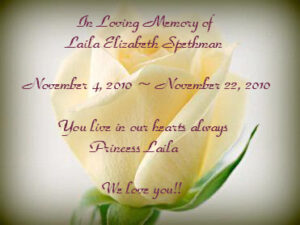Monthly Archives: November 2023
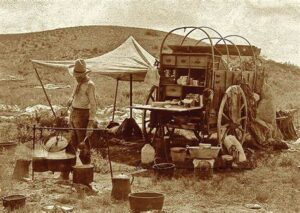 After watching numerous old western shows about cattle drives, most of us would automatically assume that a chuckwagon is a staple on any cattle drive. That is not the case, however. In the early years of cattle drives, the cowboys were supposed to supply their own food, and had to survive on what they could forage and carry. With that in mind, hiring cowboys for the drive was tough. Cowboys were usually paid about $25 to $40 a month, so to have to buy food out of that too, doesn’t make cattle driving a “get rich quick” kind of job. Basically, cattle ranchers ended up with people who couldn’t get a job anywhere else, and they usually weren’t loyal or very good at their job. They might even walk off the job before the drive was over.
After watching numerous old western shows about cattle drives, most of us would automatically assume that a chuckwagon is a staple on any cattle drive. That is not the case, however. In the early years of cattle drives, the cowboys were supposed to supply their own food, and had to survive on what they could forage and carry. With that in mind, hiring cowboys for the drive was tough. Cowboys were usually paid about $25 to $40 a month, so to have to buy food out of that too, doesn’t make cattle driving a “get rich quick” kind of job. Basically, cattle ranchers ended up with people who couldn’t get a job anywhere else, and they usually weren’t loyal or very good at their job. They might even walk off the job before the drive was over.
It was a big problem for ranchers, who needed to have reliable, as well as capable cowboys to work the drives. Finally, one rancher, a man named Charles Goodnight, while pondering the problem he had in getting good working cowboys for his cattle drive. Then, he hit upon an idea. Goodnight created a type of field kitchen covered wagon. It is unknown if the name comes from the fact that the inventor is Charles (Chuck) or if it referenced chuck as a slang term for food. “Goodnight modified a Studebaker-manufactured covered wagon, a d urable Civil War army-surplus wagon, to suit the needs of cowboys driving cattle from Texas to sell in New Mexico. He added a ‘chuck box’ to the back of the wagon, with drawers and shelves for storage space and a hinged lid to provide a flat working surface. A water barrel was also attached to the wagon and canvas was hung underneath to carry firewood. A wagon box was used to store cooking supplies and cowboys’ personal items.” It is said that Goodnight’s main motivation for the chuckwagon, was to be able to hire a better class of cowboy and keep them throughout the cattle drive.
urable Civil War army-surplus wagon, to suit the needs of cowboys driving cattle from Texas to sell in New Mexico. He added a ‘chuck box’ to the back of the wagon, with drawers and shelves for storage space and a hinged lid to provide a flat working surface. A water barrel was also attached to the wagon and canvas was hung underneath to carry firewood. A wagon box was used to store cooking supplies and cowboys’ personal items.” It is said that Goodnight’s main motivation for the chuckwagon, was to be able to hire a better class of cowboy and keep them throughout the cattle drive.
“Chuckwagon food typically included easy-to-preserve items such as baked beans, salted meats, coffee, and sourdough biscuits. Food would also be gathered en route. There was no fresh fruit, vegetables, or eggs available, and meat was not fresh unless an animal was injured during the run and therefore had to be killed. The meat they ate was greasy cloth-wrapped bacon, salt pork, and beef, usually dried, salted or smoked. On cattle drives, it was common for the “cookie” who ran the wagon to be second in authority only to the “trailboss.” The cookie would often act as cook, barber, dentist, and banker.” A typical trail boss made $100 to $125 a month, and the cook usually made about $60. 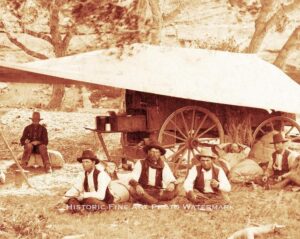 The cook was vital to the cattle drive and was not to be crossed. The men were to keep their distance from the chuckwagon, because dust would get in the food. The horses left camp downwind of the chuckwagon for the same reason. No one dared take the last serving of food until they were sure that everyone had been served. To leave food on their plates was an insult to the cook. The cooks had long days…up before dawn to prepare food. After the men left for work, they cleaned up camp and washed dishes, then went to the next camp site to begin dinner for the men’s arrival. After dinner they cleaned up and went to bed. The next day would soon arrive. They more than earned their wage and the special wagon they got to use.
The cook was vital to the cattle drive and was not to be crossed. The men were to keep their distance from the chuckwagon, because dust would get in the food. The horses left camp downwind of the chuckwagon for the same reason. No one dared take the last serving of food until they were sure that everyone had been served. To leave food on their plates was an insult to the cook. The cooks had long days…up before dawn to prepare food. After the men left for work, they cleaned up camp and washed dishes, then went to the next camp site to begin dinner for the men’s arrival. After dinner they cleaned up and went to bed. The next day would soon arrive. They more than earned their wage and the special wagon they got to use.
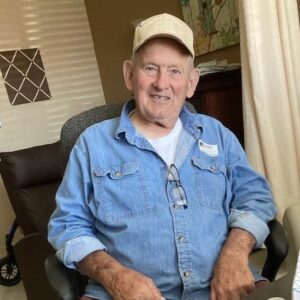
 My husband, Bob and I were in Montana recently, and we had the opportunity to visit with his uncle, Butch Schulenberg. It had been a while since we had seen Butch and his sweet wife, Charlys. It was such a nice visit. We sat and talked about how life had been treating us all. Things change as the years go by, but they have had some challenges this year. Nevertheless, they are weathering the storms well. Uncle Butch always has taken life with a little grain of salt and a whole lot of humor. It’s a great way to view the things life brings us, and it makes their home a happy one.
My husband, Bob and I were in Montana recently, and we had the opportunity to visit with his uncle, Butch Schulenberg. It had been a while since we had seen Butch and his sweet wife, Charlys. It was such a nice visit. We sat and talked about how life had been treating us all. Things change as the years go by, but they have had some challenges this year. Nevertheless, they are weathering the storms well. Uncle Butch always has taken life with a little grain of salt and a whole lot of humor. It’s a great way to view the things life brings us, and it makes their home a happy one.
With things that happened this year with Charlys, their grandson, Christian Schulenberg, who is a CNA at the  nursing home in Forsyth, Montana, is living with them now, so they have extra help when he isn’t working. We are so grateful to Christian for being there for his grandparents. Charlys will be ok, and this situation is temporary. She is in great spirits, and we had a great time visiting with her and Butch while we were there. Butch says he is the chief cook and bottle washer now, and that is ok, because he loves his bride very much. While he may have a few more “duties” these days, for Butch anyway, caregiving has given him time at a slower pace. Where he might have been out and about in town, he is home much more. It isn’t that Charlys needs so much now, but he likes to stick a little closer to her, just in case. Butch is also a great fan of Forsyth school sports. He can’t always make the games, but he always cheers them on, and he wants to know the outcome of the games.
nursing home in Forsyth, Montana, is living with them now, so they have extra help when he isn’t working. We are so grateful to Christian for being there for his grandparents. Charlys will be ok, and this situation is temporary. She is in great spirits, and we had a great time visiting with her and Butch while we were there. Butch says he is the chief cook and bottle washer now, and that is ok, because he loves his bride very much. While he may have a few more “duties” these days, for Butch anyway, caregiving has given him time at a slower pace. Where he might have been out and about in town, he is home much more. It isn’t that Charlys needs so much now, but he likes to stick a little closer to her, just in case. Butch is also a great fan of Forsyth school sports. He can’t always make the games, but he always cheers them on, and he wants to know the outcome of the games.

 Butch loves taking care of his yard, and it always looks beautiful. Probably its greatest feature is the one that Butch doesn’t have to do anything with…the view of the Yellowstone River. They have a totally unobstructed view of it, and they are above it, so the view looking down on the river is stunning, as his many pictures will show. Butch works pretty tirelessly on his little flower gardens too, and they are really pretty. The only problem he had this year is that he added chickens, and the darned things just wouldn’t lay any eggs. I think he got a bum deal, and he should probably ask for a refund, but that’s just my opinion. Today is Butch’s 83rd birthday. Happy birthday Uncle Butch. We are so glad we got to visit you guys. Have a great day!! We love you!!
Butch loves taking care of his yard, and it always looks beautiful. Probably its greatest feature is the one that Butch doesn’t have to do anything with…the view of the Yellowstone River. They have a totally unobstructed view of it, and they are above it, so the view looking down on the river is stunning, as his many pictures will show. Butch works pretty tirelessly on his little flower gardens too, and they are really pretty. The only problem he had this year is that he added chickens, and the darned things just wouldn’t lay any eggs. I think he got a bum deal, and he should probably ask for a refund, but that’s just my opinion. Today is Butch’s 83rd birthday. Happy birthday Uncle Butch. We are so glad we got to visit you guys. Have a great day!! We love you!!
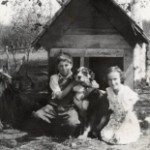
 My aunt, Ruth Wolfe was my dad, Allen Spencer’s younger sister. She had three older siblings, Laura Fredrick, William Spencer, and my dad; as well as two older half siblings, Dorothy (died when she was six months) and Norman Spencer. To my knowledge, the kids might have met Norman a few times, but not very much for sure. That makes me sad, because from what I have learned of Norman, he was a wonderful man. I wish they all could have known him better. Life as a child was good for Aunt Ruth, even though money was never abundant. Aunt Ruth learned to be resourceful, and she really excelled at it.
My aunt, Ruth Wolfe was my dad, Allen Spencer’s younger sister. She had three older siblings, Laura Fredrick, William Spencer, and my dad; as well as two older half siblings, Dorothy (died when she was six months) and Norman Spencer. To my knowledge, the kids might have met Norman a few times, but not very much for sure. That makes me sad, because from what I have learned of Norman, he was a wonderful man. I wish they all could have known him better. Life as a child was good for Aunt Ruth, even though money was never abundant. Aunt Ruth learned to be resourceful, and she really excelled at it.
Aunt Ruth had a softer side. She could play almost any musical instrument by simply picking it up and playing. I’m not saying that she was a world class musician, but she could make music, and that is far more than I could do with an instrument. Aunt Ruth could “spin a yarn” too. Sometimes I wasn’t sure if her stories were true or fiction, but I think they were likely a mix of both. She knew a lot about weather patterns, which she demonstrated once in our kitchen, when she noticed that the wind (which is almost never still in Casper), had stopped. She jumped up and went to the window, proclaiming that there was a tornado or funnel cloud nearby. We later learned that there had been a funnel cloud…and I was shocked.
Aunt Ruth was also quite self-sufficient. She gardened and canned, and she could build things too. All these things led later to the family’s ability to be “off the grid,” when living “off the grid” was not a known word or a “thing” at all. While living “off the grid” was really unusual in her lifetime, Aunt Ruth, her husband, Uncle Jim Wolfe, and their family chose that lifestyle in the 1980s. She was one of those people who could make a meal 
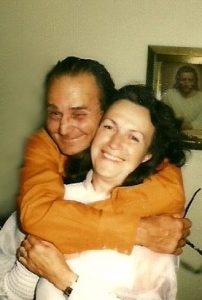 out of what most of us would view as nothing. Dinnertime was simply “different” by today’s standards, but them these days, anything that isn’t a hamburger is considered unusual…ok, maybe not exactly, but you get the picture. I’m not saying that Aunt Ruth ate “possum grits” or squirrel, but I can’t say she didn’t either. I suppose in some places, those things might be considered a delicacy, but I’ll pass. Nevertheless, at Aunt Ruth’s place, you might get mustard and onion sandwiches (that might have been invented by Uncle Jim and maybe my dad helped), but you might get it at Aunt Ruth’s table…probably not my cup of tea either, but I’m not a huge onion fan. Nevertheless, Aunt Ruth could fix just about any meal and make it taste great. Today would have been Aunt Ruth’s 98th birthday. Happy birthday in Heaven, Aunt Ruth. We love and miss you very much.
out of what most of us would view as nothing. Dinnertime was simply “different” by today’s standards, but them these days, anything that isn’t a hamburger is considered unusual…ok, maybe not exactly, but you get the picture. I’m not saying that Aunt Ruth ate “possum grits” or squirrel, but I can’t say she didn’t either. I suppose in some places, those things might be considered a delicacy, but I’ll pass. Nevertheless, at Aunt Ruth’s place, you might get mustard and onion sandwiches (that might have been invented by Uncle Jim and maybe my dad helped), but you might get it at Aunt Ruth’s table…probably not my cup of tea either, but I’m not a huge onion fan. Nevertheless, Aunt Ruth could fix just about any meal and make it taste great. Today would have been Aunt Ruth’s 98th birthday. Happy birthday in Heaven, Aunt Ruth. We love and miss you very much.
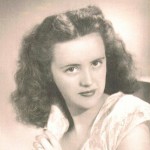
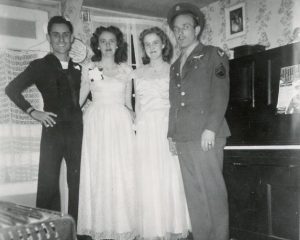 My aunt, Evelyn Hushman was the oldest sibling of my grandparents, George and Hattie Byer. While she and my mom were eight years between Aunt Evelyn and my mom, Collene Spencer were good friends, as well as being sisters. When my mom and dad, Allen Spencer were dating, they sometimes double dated with Aunt Evelyn and her husband, George Hushman, who were married six years before my parents. They were all good friends and remained good friends for the rest of their lives. Probably the strangest double date was the one where a train, with no lights, blowing no whistle, at a dark uncontrolled crossing, hit their car. If Uncle George hadn’t caught it out of the corner of his eye and yelled at my dad; and had my dad not responded quickly turning with the train and causing only damage to the vehicle, the collision could have been disastrous. Both couples walked away unhurt…the car, not so much!!
My aunt, Evelyn Hushman was the oldest sibling of my grandparents, George and Hattie Byer. While she and my mom were eight years between Aunt Evelyn and my mom, Collene Spencer were good friends, as well as being sisters. When my mom and dad, Allen Spencer were dating, they sometimes double dated with Aunt Evelyn and her husband, George Hushman, who were married six years before my parents. They were all good friends and remained good friends for the rest of their lives. Probably the strangest double date was the one where a train, with no lights, blowing no whistle, at a dark uncontrolled crossing, hit their car. If Uncle George hadn’t caught it out of the corner of his eye and yelled at my dad; and had my dad not responded quickly turning with the train and causing only damage to the vehicle, the collision could have been disastrous. Both couples walked away unhurt…the car, not so much!!
The couples also attended the military ball, and later they bowled on the same league together. They just enjoyed spending time together. While Aunt Evelyn and Uncle George’s five kids were older that my sisters and me, (my cousin Greg Hushman is just a month older that my oldest sister, Cheryl Masterson), we all got along well, and our parents made sure we got lots of playtime together. I’m sure that they also figured that with so many kids, it was getter to just get us together and maybe we would entertain each other. We did, but I can’t say that we never got into trouble either…not any real trouble anyway.
Their weekly “double dates” ended when they quit bowling, and the was probably a rather sad time for all of 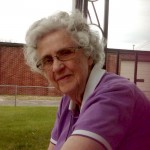
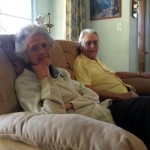 them…like the end of an era. I suppose that all things must come to an end, but that doesn’t mean we have to like it too. Aunt Evelyn bowled for quite some time after that, and I bowled on her team as a sub sometimes, but she was the only one of the four that continued to bowl for a time. Now, all four of them are together in Heaven again. I wonder if they still get together for outings and dinners. Maybe they even go bowling, who knows. I like to think of them that way. Today would have been Aunt Evelyn’s 95th birthday. Happy birthday in Heaven, Aunt Evelyn. We love and miss you very much.
them…like the end of an era. I suppose that all things must come to an end, but that doesn’t mean we have to like it too. Aunt Evelyn bowled for quite some time after that, and I bowled on her team as a sub sometimes, but she was the only one of the four that continued to bowl for a time. Now, all four of them are together in Heaven again. I wonder if they still get together for outings and dinners. Maybe they even go bowling, who knows. I like to think of them that way. Today would have been Aunt Evelyn’s 95th birthday. Happy birthday in Heaven, Aunt Evelyn. We love and miss you very much.
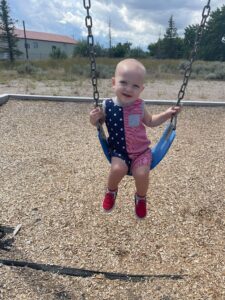
 My great grandnephew, Aysa Balcerzak is such a happy little boy. As with all two-year-old boys, he is curious, fearless, and wants to do anything his big sister, Reece is doing. Aysa is so energetic…bouncing all over the place. He and his sister love to dance around the house, and Aysa does his best to dance just like his big sis, but he isn’t really very successful at that…yet anyway. Reece, being the oldest, has had some dance lessons, and Aysa probably won’t, because while he likes doing what his sister does, dancing is not likely to be his career of choice. I could be wrong, but it seems unlikely, because Aysa is all boy. Still, the music “moves him” so he will most likely do some dancing in his lifetime. And he knows how to ham it up.
My great grandnephew, Aysa Balcerzak is such a happy little boy. As with all two-year-old boys, he is curious, fearless, and wants to do anything his big sister, Reece is doing. Aysa is so energetic…bouncing all over the place. He and his sister love to dance around the house, and Aysa does his best to dance just like his big sis, but he isn’t really very successful at that…yet anyway. Reece, being the oldest, has had some dance lessons, and Aysa probably won’t, because while he likes doing what his sister does, dancing is not likely to be his career of choice. I could be wrong, but it seems unlikely, because Aysa is all boy. Still, the music “moves him” so he will most likely do some dancing in his lifetime. And he knows how to ham it up.

Aysa’s parents try to give their children a variety of activities to try out, and I personally think that little Aysa rather likes the horse he got to try. What kid wouldn’t, after all? He didn’t seem to be afraid, but then his daddy, Keifer Balcerzak was right there holding him, so the ground didn’t seem so far down, and the horse didn’t seem quite so big, and if Daddy thought it was ok, it must be. I’m sure there will be many new experiences in the future. Keifer plays baseball, and I’m sure that he is looking forward to the day when he can get his son started in T-Ball and beyond. Someday I’m sure they will be on a father/son team, just like Keifer has been with his dad, Aysa’s grandpa, Dave Balcerzak. With the love of sports that runs in the Balcerzak clan, I’m sure there will be other enjoyable events in Aysa’s life too…like football games to watch and maybe play. Of course, those things are down the road a little be, because Aysa is only two years old, after all.


While Daddy may be Aysa’s best buddy, his mommy, Katie Balcerzak is definitely his cuddle of choice. As we all know, things like scraped knees, bumped heads, and fights with big sister require a little hug from the one person who can always make it all better…Mommy. She has been the person who nurtured him, and yet, allowed him to be all boy. She was the person who made sure that when he had to go do girl’s stuff with his big sis, he had snacks to make it all worthwhile. Mommies really are the best…at least until the teenage years. Then, all bets are off!! Still, Aysa’s parents are pretty cool, so I’m sure it will be fine. Today is Aysa’s 2nd birthday. Happy birthday Aysa!! Have a great day!! We love you!!
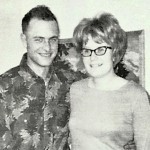
 My husband, Bob’s uncle, Eddie Hein was a sweet man who was an encouragement to many people. His children were his pride and joy, and he would do anything in his power to make their lives better. When Larry wanted to open a mechanics shop, Eddie was totally onboard. Eddie always loved mechanics, and seeing Larry start a career in that field was pleasing to him. Eddie loved vintage cars and would have loved to spend hours working to restore them. Of course, that wasn’t feasible, so watching his same work on cars sometimes filled the mechanics gap, in his life…at least the one that existed in his latter years.
My husband, Bob’s uncle, Eddie Hein was a sweet man who was an encouragement to many people. His children were his pride and joy, and he would do anything in his power to make their lives better. When Larry wanted to open a mechanics shop, Eddie was totally onboard. Eddie always loved mechanics, and seeing Larry start a career in that field was pleasing to him. Eddie loved vintage cars and would have loved to spend hours working to restore them. Of course, that wasn’t feasible, so watching his same work on cars sometimes filled the mechanics gap, in his life…at least the one that existed in his latter years.
His daughter, Kim Arani had very different goals and dreams than her dad, which makes sense. Most women don’t dream of becoming a mechanic. Kim chose later to move to Texas, because she absolutely hates the Montana winters, and I can’t say as I blame her. Even though Kim lived far away know, Eddie and Pearl were very supportive of her dreams, and were very excited to attend her wedding and give the bride away. It was a dream wedding, and while Eddie had suffered a stroke prior to the wedding, he was able to make the trip and walk his daughter down the aisle…on the beach.
While Eddie was dedicated to his children, Larry and Kim, he was most dedicated to his loving wife, Pearl. When they were off work, they were together. They gardened together and worked on the house together. Their lives 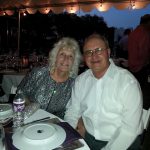
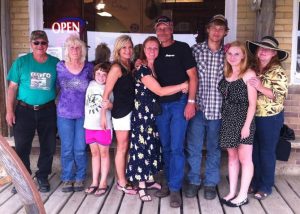 were intertwined. When Eddie had his stroke, Pearl really stepped up to make sure Eddie had everything he needed. She drove him lots of miles to do his therapy. She took care of him at home. She nursed him back to health, and Eddie was grateful. He knew he loved her from the very start, and she proved to be the best thing that ever happened to him. Today would have been Eddie’s 80th birthday. Happy birthday in Heaven, Eddie!! We love and miss you very much!!
were intertwined. When Eddie had his stroke, Pearl really stepped up to make sure Eddie had everything he needed. She drove him lots of miles to do his therapy. She took care of him at home. She nursed him back to health, and Eddie was grateful. He knew he loved her from the very start, and she proved to be the best thing that ever happened to him. Today would have been Eddie’s 80th birthday. Happy birthday in Heaven, Eddie!! We love and miss you very much!!

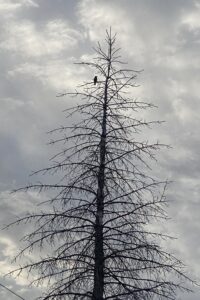 I am a summer girl, but I also like spring and fall, unless they try to act too much like winter. For the most part, I really don’t like winter at all. In Wyoming, winter means cold, wind, and snow…all dirty four-letter words, if you ask me. Nevertheless, I am not opposed to the time change, like many other people are. For me, the “Spring back” part of the change, which gives an extra hour of light in the early morning is very nice, because I love to go walk in the early morning, and as the darker days ascend on us, I can no longer head out to walk at 6:30 in the morning, because it is too dark. I much wait until later in the day to try for a walk on the path near my house…if the four-letter word, wind doesn’t rear its ugly head, that is.
I am a summer girl, but I also like spring and fall, unless they try to act too much like winter. For the most part, I really don’t like winter at all. In Wyoming, winter means cold, wind, and snow…all dirty four-letter words, if you ask me. Nevertheless, I am not opposed to the time change, like many other people are. For me, the “Spring back” part of the change, which gives an extra hour of light in the early morning is very nice, because I love to go walk in the early morning, and as the darker days ascend on us, I can no longer head out to walk at 6:30 in the morning, because it is too dark. I much wait until later in the day to try for a walk on the path near my house…if the four-letter word, wind doesn’t rear its ugly head, that is.
Oh, I know many people don’t agree, because they are now feeling like the evening comes far too soon, and they don’t like driving home from work in the dark. As my daughter, Amy Royce said when we were discussing the time change (she’s not a fan), and I pointed out the light early mornings to her, “Hahaha!! It’s six of one or half a dozen of the other!!” Yes, that is true, but for me, the fact that I’m retired, and don’t have to drive home in the dark, it doesn’t really matter…most of the time.
This morning, however, it mattered. This morning was a balmy 51° with only eight mile per hour winds. That coupled with the fact that the time change made it light at 6:30, meant that my walk was on. It was what I 
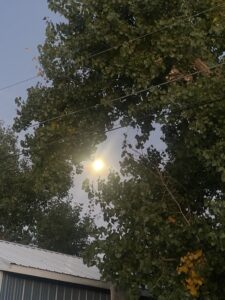 would call a November Gift. The sky was gray, and that isn’t my favorite sky color, but I can deal with that. It tried to act like it was going to rain, but only accomplished a few little sprinkles, so I kept going. I prefer the warm, early morning summer days, but November does hide another good thing…the bugs are gone. In the summer I need bug repellant, and now I don’t. Of course, if there was a rogue bug out there, he couldn’t find my skin…except for my face, so it’s a wash. I will always prefer late spring and summer to late fall and winter, but I’m not one to let a good gift go to waste either. Having a morning in November with perfect walking conditions is a rare thing indeed, and I quickly got going and headed out to enjoy that November Gift.
would call a November Gift. The sky was gray, and that isn’t my favorite sky color, but I can deal with that. It tried to act like it was going to rain, but only accomplished a few little sprinkles, so I kept going. I prefer the warm, early morning summer days, but November does hide another good thing…the bugs are gone. In the summer I need bug repellant, and now I don’t. Of course, if there was a rogue bug out there, he couldn’t find my skin…except for my face, so it’s a wash. I will always prefer late spring and summer to late fall and winter, but I’m not one to let a good gift go to waste either. Having a morning in November with perfect walking conditions is a rare thing indeed, and I quickly got going and headed out to enjoy that November Gift.
 Vnukovo Airport was experiencing heavy fog on November 5, 1946. Due to the resulting low visibility conditions and a high number of aircraft bound for Moscow, including an Aeroflot LI-2 (registration CCCP-L4181) that was being ferried from Voronezh to Moscow. The LI-2, along with a number of other planes, were put in a holding pattern for 75 minutes. These things are a common practice, but maybe not for so long.
Vnukovo Airport was experiencing heavy fog on November 5, 1946. Due to the resulting low visibility conditions and a high number of aircraft bound for Moscow, including an Aeroflot LI-2 (registration CCCP-L4181) that was being ferried from Voronezh to Moscow. The LI-2, along with a number of other planes, were put in a holding pattern for 75 minutes. These things are a common practice, but maybe not for so long.
Finally, at 5:45pm, local time, the crew of the LI-2 was cleared to land and began their approach, still in a thick fog. It was a difficult approach, and the crew decided to go around. In all, five ADF approaches under radar guidance were attempted. Unfortunately, during the fifth approach the plane suffered fuel exhaustion. Immediately, the plane lost altitude and struck light poles and crashed. Fog creates very unique problems, and to complicate matters, that night three Aeroflot aircraft also crashed near Vnukovo Airport, killing a total of 19 occupants.
The first one, Aeroflot LI-2 (registration CCCP-L4181) crashed near Yamshchina, Moskovskaya, Russia. The determined cause was fuel exhaustion after being in a holding pattern for two hours, killing all five crew on board. Then, an Aeroflot C-47 (registration CCCP-L946) crashed in fog at Vnukovo Airport while attempting a go-around after being in a holding pattern for two hours, killing 13 of the 26 on board. Finally, an Aeroflot LI-2 (registration CCCP-L4207) crashed at Vnukovo Airport after repeated landing attempts due to fuel exhaustion after being in a holding pattern for 75 minutes, killing one of 26 on board.
The Vnukovo Airport is Moscow’s oldest operating airport. Originally opened for military operations during the Second World War, it became a civilian facility after the war. The Soviet government approved its construction in 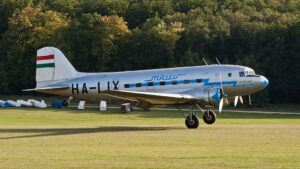 1937, because the older Khodynka Aerodrome, which was located much closer to the city center, was becoming overloaded. That airport closed by the 1980s. Vnukovo was built by several thousand inmates of Likovlag, which was a Gulag concentration camp created specifically for this purpose. Vnukovo opened on July 1, 1941. While the airport was old, it was not the cause of the November 5, 1946 crashes. More likely the pilots and flight controllers, who were preoccupied with the fog, simply forgot to monitor the fuel levels, and missed the fact that they were dangerously low. It is odd, however, that three were missed at the same time, and very sad that 19 people lost their lives because of it.
1937, because the older Khodynka Aerodrome, which was located much closer to the city center, was becoming overloaded. That airport closed by the 1980s. Vnukovo was built by several thousand inmates of Likovlag, which was a Gulag concentration camp created specifically for this purpose. Vnukovo opened on July 1, 1941. While the airport was old, it was not the cause of the November 5, 1946 crashes. More likely the pilots and flight controllers, who were preoccupied with the fog, simply forgot to monitor the fuel levels, and missed the fact that they were dangerously low. It is odd, however, that three were missed at the same time, and very sad that 19 people lost their lives because of it.
 The Cold War, and the Soviet Union’s sudden announcement on August 30, 1961, to end a three-year moratorium on nuclear testing, brought about a shift in US policy, and a number of to nuclear test operations. One, known as Operation Fishbowl was a series of high-altitude nuclear tests in 1962 that were carried out by the United States as a part of the larger Operation Dominic nuclear test program. Flight-test vehicles were designed and manufactured by Avco Corporation. The test planned for the first half of 1962, called Bluegill, Starfish and Urraca were originally planned for the first half of 1962, but the first test attempt was delayed until June. Planning was complex, but necessary.
The Cold War, and the Soviet Union’s sudden announcement on August 30, 1961, to end a three-year moratorium on nuclear testing, brought about a shift in US policy, and a number of to nuclear test operations. One, known as Operation Fishbowl was a series of high-altitude nuclear tests in 1962 that were carried out by the United States as a part of the larger Operation Dominic nuclear test program. Flight-test vehicles were designed and manufactured by Avco Corporation. The test planned for the first half of 1962, called Bluegill, Starfish and Urraca were originally planned for the first half of 1962, but the first test attempt was delayed until June. Planning was complex, but necessary.
The launch sites were planned from Johnston Island in the Pacific Ocean north of the equator. The island was the chosen launch site, rather than the other locations in the Pacific Proving Grounds. However, the testing was not without push back. Even as early as 1958, Lewis Strauss, t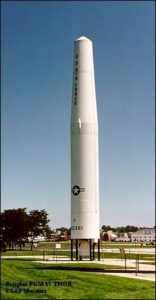 hen chairman of the United States Atomic Energy Commission, opposed doing any high-altitude tests at locations that had been used for earlier Pacific nuclear tests. The motivation for concern was the fear of the flash from the nighttime high-altitude detonations might blind civilians who were living on nearby islands. Still, Johnston Island was a remote location. It was more distant from populated areas than the other potential test locations. Nevertheless, in order to protect residents of the Hawaiian Islands from flash blindness or permanent retinal injury from the bright nuclear flash, the nuclear missiles of Operation Fishbowl were launched toward the southwest of Johnston Island. The detonation part of the test would be farther from Hawaii.
hen chairman of the United States Atomic Energy Commission, opposed doing any high-altitude tests at locations that had been used for earlier Pacific nuclear tests. The motivation for concern was the fear of the flash from the nighttime high-altitude detonations might blind civilians who were living on nearby islands. Still, Johnston Island was a remote location. It was more distant from populated areas than the other potential test locations. Nevertheless, in order to protect residents of the Hawaiian Islands from flash blindness or permanent retinal injury from the bright nuclear flash, the nuclear missiles of Operation Fishbowl were launched toward the southwest of Johnston Island. The detonation part of the test would be farther from Hawaii.
The Urraca test involved about a 1 megaton yield at very high altitude of just over 621 miles. With the damage caused to satellites by the Starfish Prime detonation, the proposed Urraca test was always controversial. Because they couldn’t put the fears to rest, the Urraca test was finally canceled, and an extensive re-evaluation of the Operation Fishbowl plan as a whole was made during the 82-day operations pause after the Bluegill Prime disaster of July 25, 1962. When prime was added to a test, it indicated that the main test had failed, so when Bluegill Prime failed, it was the second test fail for that test series, which in this case (Bluegill Double Prime), ended in disaster when the Thor suffered a stuck valve preventing the flow of LOX to the combustion chamber. The engine lost thrust and unburned RP-1 spilled down into the hot thrust chamber, igniting and starting a fire around the base of the missile. Bluegill would go on to have two more tests, before they finally achieved success.

A test named Kingfish was added during the early stages of Operation Fishbowl planning. Two low-yield tests, Checkmate and Tightrope, were also added during the project, so the final number of tests in Operation Fishbowl was five. Tightrope was the last atmospheric nuclear test conducted by the United States, as the Limited Test Ban Treaty came into effect shortly thereafter. A total of Seven rockets carrying scientific instrumentation were launched from Johnston Island in support of the Tightrope test, which was the final atmospheric test conducted by the United States. I suppose testing is necessary, and I don’t know where else or how else it could be done, but the whole thing seems crazy to me. I do think that in light of this and other nuclear test disasters, care should be taken to better protect human life.
